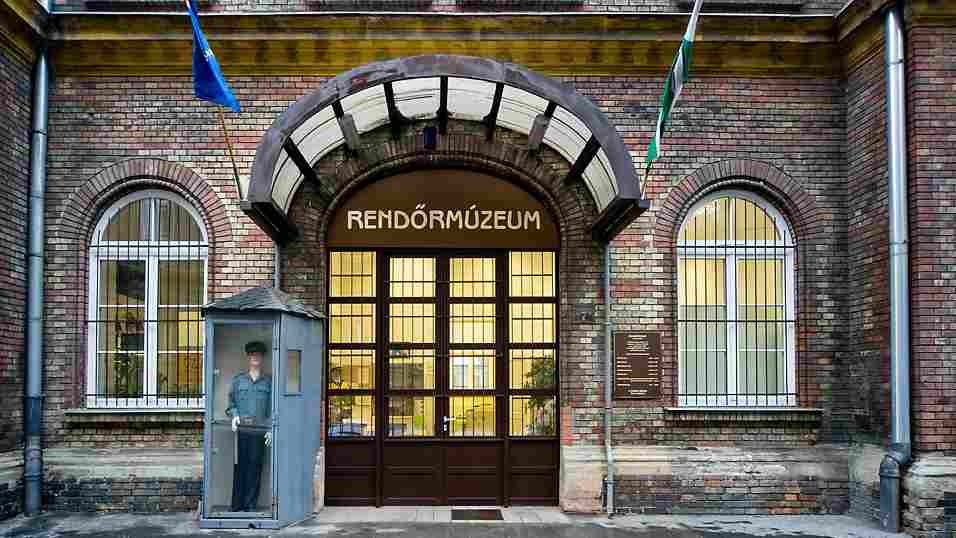For those who have surpassed obvious museum mainstream in Budapest and are searching for something more contrary, I recommend a visit to the Rendőrmúzeum/Police Museum at 5 Mosonyi Street, by the number 24 tram end-stop at Keleti railway station.
This irregular and perhaps unexpected event, formerly known as the Crime Museum, hosts two permanent exhibition halls. There is an official police “dress attire” section, with a splendid miscellanea of Hungarian police uniforms, medals, honours, trophies, certificates and so forth, dating from 1848 to the present day. But the real trepidation comes with the “main feature” when proceeding to the Kriminalisztikai Kiállítas/the Criminal Exhibition hall. Here, as the twilight world of the police and criminal community, and “Kántor” the celebrated German shepherd police dog, await your arrival.

Although the visitor will notice the eerie atmosphere, it is reassuring to learn from the displays that there has been a wide variety of closed cases, and no need worry about them no more. The visitor becomes an observer of forensic equipment, surveillance photos and other artefacts capturing local and nationwide crimes, mainly from the mid to late 20th century.
Here’s our guide to the museums of Budapest!
As common criminals – pickpockets, shoplifters, vandals and prostitutes take to the scene – alongside with various victims. As they are pictured, though discreetly “masked” to conceal their identities for ‘case sensitive’ reasons, should any of their relatives still be alive today, despite being clearly caught on camera. A not-so-obvious exposé is the set of dubious weights and measures used to serve up insufficient amounts of produce to unknowing customers at certain shops and market stalls.
From there we proceed to the more bourgeois white-collar crime displays, clearly relating to more high ranking and sophisticated frauds.
Car-related offences could be referred to as “life in the low lane”, with elaborate photographic illustrations of stolen, raided and abandoned vehicles. See the more advanced offences include falsifying car registration plates, as noted with the infamous 1995 Miskolc “Bonnie and Clyde” case, when a former security guard and his young lover/accomplice stole HUF 27 million from a bank where he worked, and went into hiding while living on their illicit loot.

In April 2000, the couple used a stolen car and weapons to rob a security van but then drove through a red light at Miskolc. A police patrol car saw them and gave chase. They managed to flee and a manhunt began. A commando raid on a garage where they were hiding, perhaps following a tip-off, saw them caught and given lengthly prison sentences.
One of the more fascinating displays at the Police Museum is the collection of convincing-looking forged banknotes, clearly meant for buying goods or selling on the streets to unsuspecting tourists.

But the main “intrigue” has to be Hungary’s biggest robbery, which took place at the Szépművészeti Múzeum/Museum of Fine Arts on November 5, 1983, when seven Italian Renaissance masterpieces were stolen and spirited out of the country, eventually making their way to Greece.
Not only was this consignment worth millions even then, but symbolically the collection including works by Raphael, Giorgione, Tintoretto and Tiepolo was part of the Hungarian national heritage. The most iconic of the stolen treasures was Raphael’s “Esterházy Madonna”, painted in 1508 and sold to the museum in 1870 by the Eszterházys, aristocrats from Austro-Hungarian Empire times.

In something similar to the “Pink Panther” films, the perpetrators climbed scaffolding that had been erected next to the building for maintenance reasons and got through a window.
The burglar alarm was not in operation at the time.
The paintings were delivered to a wealthy Athens olive oil manufacturer who conveniently had a brother who was an art dealer based in New York, but fortunately the paintings were discovered at a nearby Greek monastery before they got that far. The gang consisted of three Hungarians, who were rounded up in their homeland in December 1983, and five Italians who were arrested soon afterwards. The artworks finally returned to Hungary on January 23, 1984 by plane, to go back on more secure display.
The museum exhibits are mainly described in Hungarian, but little explanation is needed when the more disturbing items are reached. Here, graphic imagery shows accidents and murders of all kinds. There is a small caché of confiscated home-made weapons such as wooden pistols, pen pistols and an umbrella gun, all of which were clearly as effective as the real thing. They were designed for, and used for, serious offences. Caution is advised for visitors, and school groups are barred from this section.
All in all, the museum’s extensive artifacts collected along the way from various crime scenes take you on a bewildering trip into the perilous side of life.
Stunned and overwhelmed as I was at these shocking realities, the “museum noir” left a lasting impression on me. Crime, whether casual or professional, continues in much the same way today. It is all part of the job for the police forensic teams, surveillance squads and intelligence officers, tasteless as well as commendable the job can be.
It is reassuring that the police are always there – as we freely go about our lives and routines, so the villains go about theirs, day and night. It isn’t just about traffic control, keeping law and order on the streets, chasing drink-drivers and getting unfortunate characters out of scrapes.

Finally, there is a comforting, heart-warming dedication to the celebrated police dog Kántor, 1951 to 1964, now taxidermied and standing proudly.
Kántor was involved in more than 500 cases, and tributes have been paid to him in books and films for children and adults alike. If you have an appreciation for Agatha Christie as well as for the police in general, then a visit is well worthwhile.
Admission is free. See www.rendormuzeum.com (in Hungarian).






